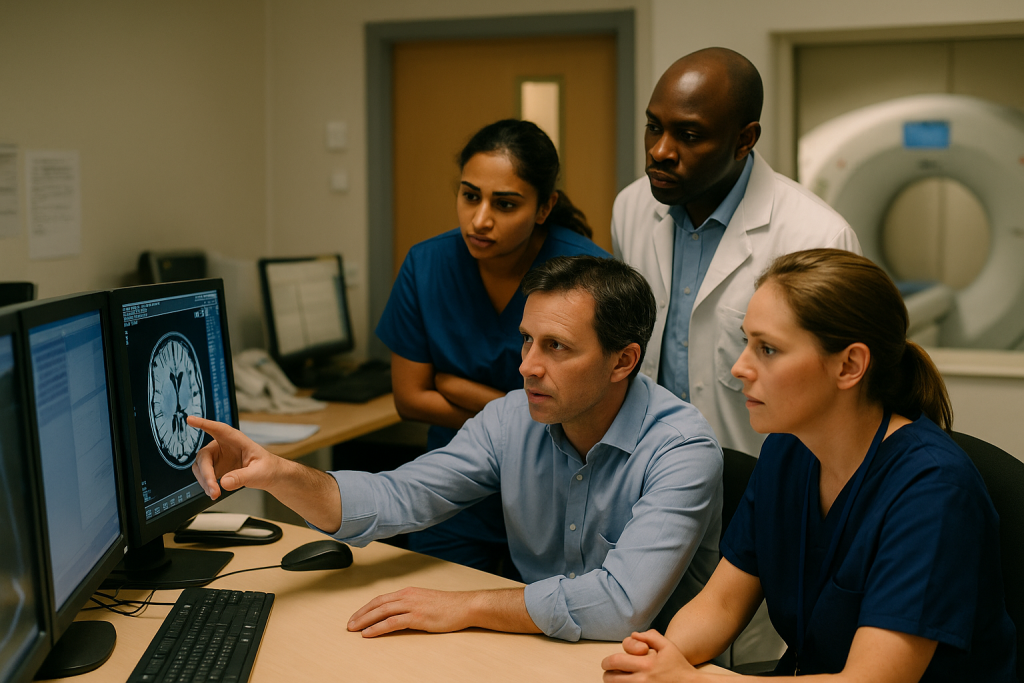Diagnostics as the Critical Path: DM01 Signals and Where to Add Capacity Fast
30 Sep 2025 | Altin Biba
| Share with

Executive Summary
Diagnostics is the gateway to almost every elective and cancer pathway. Without timely scans, tests, and endoscopies, treatment cannot begin, backlogs compound, and patient risk escalates. The July 2025 DM01 data highlights worsening delays across imaging and endoscopy. As winter 2025 approaches, diagnostics is not a side issue, it is the critical path. This blog examines the state of diagnostics, where capacity is failing, the workforce challenges behind the delays, and the urgent actions NHS leaders must consider.
The Diagnostics Backlog: What the Data Shows
NHS England DM01 – July 2025
- 46 million patients waiting for key diagnostic tests, up from 2.31 million in June.
- Over 470,000 waiting more than six weeks, breaching the 99% target.
- Areas of highest pressure:
- Endoscopy (colonoscopy, gastroscopy) critical for cancer detection.
- Imaging (MRI, CT scans) underpinning orthopaedics, neurology, cardiology.
- Cardiac diagnostics (echocardiograms, angiography) linked to urgent care outcomes.
The reality: delays in diagnostics cascade into delays in elective surgery, cancer treatment, and urgent interventions.
Case Examples: Delays with Real Consequences
Endoscopy Backlogs and Cancer Pathways
HSJ reporting highlights how tens of thousands of patients are breaching six-week waits for endoscopy. Delays in colonoscopies and gastroscopies directly increase the risk of late-stage cancer diagnosis, cutting survival chances. In some regions, waits for these procedures stretch beyond 12 weeks.
Cancelled Imaging Lists
Local NHS providers, including Trusts in the Midlands and North, have been forced to cancel MRI and CT lists due to staff shortages and equipment downtime. Patients in pain are left waiting months for scans, while acute patients consume what limited capacity remains.
Community Diagnostic Centres (CDCs) Running Below Capacity
Although the government points to CDCs as proof of progress, independent analysis from the King’s Fund and Health Foundation shows many are running at partial capacity because of staff shortages. Buildings exist, but the staff to operate them do not.
These examples confirm what system leaders know: the diagnostics backlog is not simply a performance statistic. It is a frontline reality with direct impact on patient outcomes.
The Winter Overlay
- Rising UEC demand will absorb imaging slots for acutely unwell patients, pushing routine scans further back.
- Respiratory surges will require chest X-rays and CT capacity, reducing elective throughput.
- Workforce shortages (radiologists, radiographers, endoscopy nurses) will limit the ability to scale lists.
- Bed occupancy pressures will delay inpatient diagnostic access, worsening flow.
Diagnostics is the hidden bottleneck of winter resilience. Without flow through diagnostics, both urgent and elective care stall.
Workforce as the Limiting Factor
Diagnostics capacity is workforce-dependent:
- The UK has among the lowest numbers of radiologists and CT/MRI scanners per capita in Europe (OECD, 2025).
- Vacancy rates for radiographers and endoscopy nurses remain above 10%.
- Agency restrictions have sharply reduced access to flexible staffing pools that previously bolstered imaging and endoscopy lists.
Cuts to flexible staffing have undermined resilience. Diagnostics cannot be delivered without people, no workforce, no service.
The Private Sector Illusion
- Independent providers are also at capacity, with some clinics reporting routine scan waits of 8–12 weeks.
- Investor pressure on providers such as Spire Healthcare reflects fragility in the sector.
- Both NHS and private diagnostics rely on the same finite workforce. Shifting referrals without staff achieves little.
The outsourcing narrative masks the reality: without investment in staffing, outsourcing is a zero-sum game.
Where Leaders Must Add Capacity Fast
Insourcing Endoscopy and Imaging Teams
Rapid deployment of insourcing teams to run additional weekend and evening lists can ease the most dangerous backlogs, particularly cancer-linked endoscopy.
Extend Hours and Ringfence Slots
Providers that ringfence diagnostic capacity for elective patients (especially cancer pathways) can avoid total erosion of slots during winter surges.
Prioritise High-Risk Patients
Robust triage ensures patients at highest clinical risk, suspected cancer, cardiac conditions, are not left waiting while lower-priority tests consume capacity.
Deploy Digital and AI Tools
Use of AI-supported reporting in radiology can accelerate turnaround and free consultant capacity. Adoption is patchy but must be accelerated.
Support and Retain the Workforce
Retention is key this winter. Intelligent rostering, wellbeing support, and safe workloads can keep existing staff in post. Without this, attrition will accelerate.
Political Responsibility
For two years, the government has pursued a strategy of financial throttling and artificial agency demand suppression, while claiming Community Diagnostic Centres as a solution. But CDCs without staff are empty shells. The government’s refusal to invest in workforce while demanding recovery is creating systemic risk. The illusion that private providers can endlessly absorb demand is collapsing. Without urgent reinvestment in diagnostics workforce and infrastructure, waiting lists will climb higher, cancer detection will worsen, and winter resilience will fail.
Final Word – Altin Biba, MBA, AMBA
Diagnostics is the critical path. Every delayed scan or test is a delayed diagnosis, a delayed treatment, a patient left at risk. The data, the case examples, and the frontline reports all point in the same direction: diagnostics is breaking. Winter 2025 will not forgive delay or denial. Leaders must act now, insource capacity, protect slots, and support the workforce. Government must face reality: without people to deliver diagnostics, there can be no recovery.
References
- NHS England. Monthly Diagnostics (DM01) Statistics, July 2025.
- NHS England. Elective Recovery Planning Guidance, 2025.
- OECD Health Statistics 2025. Diagnostic Capacity Comparisons.
- Endoscopy Backlogs and Cancer Pathway Risks, 2025.
- Imaging Workforce Pressures and Delayed Diagnosis.
- King’s Fund. Community Diagnostic Centres: Progress and Challenges.
- Health Foundation. Diagnostics and NHS Capacity.
- Financial Times. Spire Healthcare Investor Pressure, 2025.
Leave a Comment
You must be logged in to post a comment.

30 Sep 2025 | Leave a comment
Share with socials